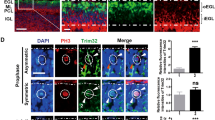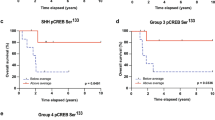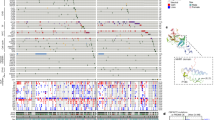Abstract
Medulloblastoma (MB) results from aberrant development of cerebellar neurons in which altered hedgehog (Hh) signalling plays a major role. We investigated the possible influence of Hh signalling on ErbB-receptor expression in MB, in particular that of the ErbB-4 CYT-1 and CYT-2 isoforms generated by alternative splicing of the cytoplasmic domain. ErbB-4 expression was downregulated in Hh-induced MBs from Patched-1+/− mice. Hh signalling (reflected by enhanced expression of the Gli1 transcription factor) inhibited ErbB-4 expression in mouse cerebellar granule progenitors and human MB cells. Analysis of 26 human primary MBs revealed a subset of 11 tumors characterized by low Gli1 levels, upregulated ErbB-4 expression and increased CYT-1:CYT-2 ratios. Interestingly, CYT-1 and Gli1 levels were inversely correlated. ErbB-4 CYT-1 and CYT-2 had different phenotypic effects in cultured MB cells: in response to neuregulin treatment, CYT-2 overexpression inhibited proliferation whereas CYT-1, which includes a phosphatidylinositol 3-kinase (PI3K)-binding site that is missing in CYT-2, enhanced resistance to starvation- and etoposide-induced apoptosis by activating PI3K/Akt signalling. CYT-1:CYT-2 ratios displayed correlation with tumor histotype and ErbB-2 levels, which are established prognostic indices for MB. These findings demonstrate that low-level Hh signalling in human MB is associated with the selective maintenance of high ErbB-4 CYT-1 expression, an alteration that exerts tumor-promoting effects.
This is a preview of subscription content, access via your institution
Access options
Subscribe to this journal
Receive 50 print issues and online access
$259.00 per year
only $5.18 per issue
Buy this article
- Purchase on Springer Link
- Instant access to full article PDF
Prices may be subject to local taxes which are calculated during checkout







Similar content being viewed by others
References
Argenti B, Gallo R, Di Marcotullio L, Ferretti E, Napolitano M, Canterini S et al. (2005). J Neurosci 25: 8338–8346.
Carpenter G . (2003). Exp Cell Res 284: 66–77.
Di Marcotullio L, Ferretti E, De Smaele E, Argenti B, Mincione C, Zazzeroni F et al. (2004). Proc Natl Acad Sci USA 101: 10833–10838.
Elenius K, Choi CJ, Paul S, Santiestevan E, Nishi E, Klagsbrun M . (1999). Oncogene 18: 2607–2615.
Elenius K, Corfas G, Paul S, Choi CJ, Rio C, Plowman GD et al. (1997). J Biol Chem 272: 26761–26768.
Ferretti E, De Smaele E, Di Marcotullio L, Screpanti I, Gulino A . (2005). Trends Mol Med 11: 537–545.
Fox IJ, Kornblum HI . (2005). J Neurosci Res 79: 584–597.
Gajjar A, Hernan R, Kocak M, Fuller C, Lee Y, McKinnon PJ et al. (2004). J Clin Oncol 22: 984–993.
Gambarotta G, Garzotto D, Destro E, Mautino B, Giampietro C, Cutrupi S et al. (2004). J Biol Chem 279: 48808–48816.
Giangaspero F, Bigner SH, Kleihues P, Pietsch T, Trojanowski JQ . (2002). In: Kleihues P, Cavenee WK (eds). Pathology and Genetics Tumors of Nervous System: Medulloblastoma. IARC Press: Lyon, pp 129–137.
Gilbertson R, Hernan R, Pietsch T, Pinto L, Scotting P, Allibone R et al. (2001). Genes Chromosomes Cancer 31: 288–294.
Gilbertson RJ, Clifford SC, MacMeekin W, Meekin W, Wright C, Perry RH et al. (1998). Cancer Res 58: 3932–3941.
Gilbertson RJ, Perry RH, Kelly PJ, Pearson AD, Lunec J . (1997). Cancer Res 57: 3272–3280.
Hahn H, Wojnowski L, Zimmer AM, Hall J, Miller G, Zimmer A . (1998). Nat Med 4: 619–622.
Junttila TT, Laato M, Vahlberg T, Soderstrom KO, Visakorpi T, Isola J et al. (2003). Clin Cancer Res 9: 5346–5357.
Junttila TT, Sundvall M, Lundin M, Lundin J, Tanner M, Harkonen P et al. (2005). Cancer Res 65: 1384–1393.
Junttila TT, Sundvall M, Maattaa J, Elenius K . (2000). Trends Cardiovasc Med 10: 304–310.
Kainulainen V, Sundvall M, Maatta JA, Santiestevan E, Klagsbrun M, Elenius K . (2000). J Biol Chem 275: 8641–8649.
Martì E, Bovolenta P . (2002). Trends Neurosci 2: 89–96.
Ni CY, Murphy MP, Golde TE, Carpenter G . (2001). Science 294: 2179–2181.
Omerovic J, Puggioni EM, Napoletano S, Visco V, Fraioli R, Frati L et al. (2004). Exp Cell Res 294: 469–479.
Ozaki M, Kishigami S, Yano R . (1998). Neurosci Res 30: 351–354.
Pazzaglia S, Mancuso M, Atkinson MJ, Tanori M, Rebessi S, Majo VD et al. (2002). Oncogene 21: 7580–7584.
Rieff HI, Raetzman LT, Sapp DW, Yeh HH, Siegel RE, Corfas G . (1999). J Neurosci 19: 10757–10766.
Ruiz i Altaba A, Sanchez P, Dahmane N . (2002). Nat Rev Cancer 2: 361–382.
Taipale J, Chen JK, Cooper MK, Wang B, Mann RK, Milenkovic L et al. (2000). Nature 406: 1005–1009.
Tidcombe H, Jackson-Fisher A, Mathers K, Stern DF, Gassmann M, Golding JP . (2003). Proc Natl Acad Sci USA 100: 8281–8286.
Yarden Y, Sliwkowski MX . (2001). Nat Rev Mol Cell Biol 2: 127–137.
Zhang D, Sliwkowski MX, Mark M, Frantz G, Akita R, Sun Y et al. (1997). Proc Natl Acad Sci USA 94: 9562–9567.
Acknowledgements
This work was partially supported by Associazione Italiana per la Ricerca sul Cancro, Telethon Grant GGP04168, the National Research Council, the Ministry of University and Research, the Ministry of Health and Center of Excellence for Biology and Molecular Medicine (BEMM). E De Smaele was supported by a FIRC fellowship. We thank M Kent for editorial assistance and M Levrero for critical reading of the manuscript.
Author information
Authors and Affiliations
Corresponding author
Rights and permissions
About this article
Cite this article
Ferretti, E., Di Marcotullio, L., Gessi, M. et al. Alternative splicing of the ErbB-4 cytoplasmic domain and its regulation by hedgehog signaling identify distinct medulloblastoma subsets. Oncogene 25, 7267–7273 (2006). https://doi.org/10.1038/sj.onc.1209716
Received:
Revised:
Accepted:
Published:
Issue Date:
DOI: https://doi.org/10.1038/sj.onc.1209716
Keywords
This article is cited by
-
Foxm1 controls a pro-stemness microRNA network in neural stem cells
Scientific Reports (2018)
-
Overexpression of ERBB4 JM-a CYT-1 and CYT-2 isoforms in transgenic mice reveals isoform-specific roles in mammary gland development and carcinogenesis
Breast Cancer Research (2014)
-
A prognostic analysis of pediatrics central nervous system small cell tumors: evaluation of EGFR family gene amplification and overexpression
Diagnostic Pathology (2014)
-
Directing HER4 mRNA expression towards the CYT2 isoform by antisense oligonucleotide decreases growth of breast cancer cells in vitro and in vivo
British Journal of Cancer (2013)
-
microRNA-17-92 cluster is a direct Nanog target and controls neural stem cell through Trp53inp1
The EMBO Journal (2013)



